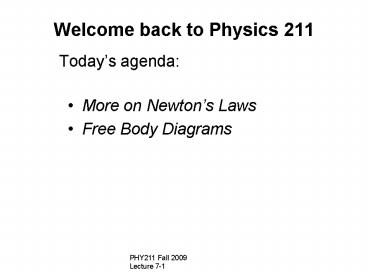Welcome back to Physics 211 - PowerPoint PPT Presentation
1 / 22
Title:
Welcome back to Physics 211
Description:
where Fnet is the vector sum of all external forces on the object considered ... A baggage handler drops your 10 kg suitcase onto a conveyor belt running at 2.0 m/s. ... – PowerPoint PPT presentation
Number of Views:275
Avg rating:3.0/5.0
Title: Welcome back to Physics 211
1
Welcome back to Physics 211
- Todays agenda
- More on Newtons Laws
- Free Body Diagrams
2
Newtons Second Law
- Second Law
- SFon object Fnet m aof object
- where Fnet is the vector sum of all external
forces on the object considered - m (inertial) mass
3
(No Transcript)
4
The force of friction is described by
- the law of friction.
- the theory of friction.
- a model of friction.
- the friction hypothesis.
5
Static Friction
The box is in static equilibrium, so the static
friction must exactly balance the pushing force
6
Static Friction
- An object remains at rest as long as fs lt fs max.
- The object slips when fs fs max.
- A static friction force fs gt fs max is not
physically possible.
where the proportionality constant µs is called
the coefficient of static friction.
7
Kinetic Friction
The kinetic friction force is proportional to the
magnitude of the normal force.
where the proportionality constant µk is called
the coefficient of kinetic friction.
8
Block on Incline
f
N
W
q
9
The magnitude of the force of kinetic friction
between two objects
What if ? gt tan-1ms ?
- depends on the type of surfaces of the objects
- depends on the normal force that the objects
exert on each other - does not depend on the surface area where the two
objects are touching - does not depend on the speed with which one
object is moving relative to the other
fk µkn
10
What if ? gt tan-1 µs ?
f
n
- Block begins to slide
- Resolve along plane
- µkWcos? - Wsin? ma
- Or
- a g(µkcos? - sin?)
W
q
11
Example Problem 43
- A baggage handler drops your 10 kg suitcase onto
a conveyor belt running at 2.0 m/s. The materials
are such that µs0.50 and µk0.30. How far is
your suitcase dragged before it is riding
smoothly on the belt?
12
Example Problem 43
- A baggage handler drops your 10 kg suitcase onto
a conveyor belt running at 2.0 m/s. The materials
are such that µs0.50 and µk0.30. How far is
your suitcase dragged before it is riding
smoothly on the belt?
13
Relationship between Mass, Weight and Gravity
Mass
- scalar quantity that describes an objects
inertia - describes the amount of matter in an object
- intrinsic property of an object
- tells us something about the object, regardless
of where the object is, what its doing, or
whatever forces may be acting on it
14
Gravity
Somewhat more loosely, gravity is a force that
acts on mass. When two objects with masses m1 and
m2 are separated by distance r, each object pulls
on the other with a force given by Newtons law
of gravity.
15
Gravity cont.
where G 6.67 x 10 -11 Nm2/kg2
near Earth
16
Chapter 7. Newtons Third Law
- Topics
- Interacting Objects
- Analyzing Interacting Objects
- Newtons Third Law
- Ropes and Pulleys
- Examples of Interacting-Object Problems
17
Interacting Objects
If object A exerts a force on object B, then
object B exerts a force on object A. The pair of
forces, as shown, is called an action/reaction
pair.
18
Newtons 3rd Law
19
Physics Education Research
fact that a large majority can recite Newtons
third law when they enter the class. Halloun and
Hestenes (1985b) have characterized student
beliefs about interactions in terms of a
dominance principle the larger (or faster or
more active) object exerts a larger force than
the smaller (or slower or less active) object.
Students tend to view an interaction as a
conflict in which the stronger wins. Its not
hard to understand how this common-sense view
comes about. After all, the effect of the
collision on the compact car is much larger than
its effect on the truck.
20
- Some of the more specific difficulties students
have with Newtons third law and with interacting
objects are - Students dont believe Newtons third law. Its
too contrary to common sense. - Students have difficulty identifying
action/reaction force pairs - They match two forces on the same object.
- They place forces on the wrong objects.
- They dont believe that long-range forces (e.g.,
gravity) have reaction forces. - Students confuse equal force with equal
acceleration.
21
Students dont understand tension
- They think that tension is the sum of the forces
exerted at the two ends of a string. - They think that tension exerts a force only in
the direction of motion. - They think that tension can pass through an
object to another string on the other side. - Students often dont recognize that objects
connected by an inextensible string must have
accelerations of equal magnitude.
22
FHW7 Due F 10/16/09
- Ch.6 EP 1, 5, 18, 20, 21
WHW8 Due F 10/21/09
- Ch.6 EP 29, 37, 46 Ch. 7 CQ 12































